The Svalbard 'Doomsday Vault' is succumbing to global warming
By Karen Graham 28 March 2019 - 19 hours ago in Environment
Just over a decade after it first opened, the world's "doomsday vault" of seeds is imperiled by global warming as the polar region where it's located warms faster than any other area on the planet.

Embedded deep in the permafrost of a remote island in the Svalbard archipelago, halfway between mainland Norway and the North Pole, the Svalbard Global Seed Vault was built to withstand the test of time - including climate change - and the challenge of any natural or man-made disasters.Opened in 2008, the seed vault contains nearly one million packets of seeds, all carefully labeled. The seeds come from almost every country in the world and are a vast sampling of unique varieties of major African and Asian food staples such as maize, rice, wheat, cowpea, and sorghum to European and South American varieties of lettuce, eggplant, squash, and potatoes.

Since opening on February 26, 2008, the Svalbard Global Seed Vault has taken in more than a million different seed varietiesLarsen, Hakon Mosvold, SCANPIX NORWAY/AFP/File
Climate change has accelerated warming in the ArcticThe seed vault was built to be indestructible but in May of 2017, soaring Arctic temperatures, coming at the end of the world's hottest year on record proved the scientists to be wrong. The extreme temperatures and rainfall started thawing the permafrost deep inside the mountain where the vault is located.A 105-page report based on research published by the Norwegian Centre for Climate Services (NCCS) released this year, revealed that the islands that make up the Svalbard archipelago where the Seed Vault is located are experiencing rapid warming.
The report states that “from 1971 to 2017, a warming of 3-5 degrees Celsius has been observed … with the largest increase in winter and the smallest in summer.” The estimated average temperature for Svalbard is -8.7 degrees Celsius."“We know that the warming in this area has been very fast during the last five decades, seen in a global perspective,” said Inger Hanssen-Bauer of the Norwegian Meteorological Institute, who was one of the editors of the study.

Rows of multicoloured homes in the town of Longyearbyen, Svalbard, Norway.Svalbard Global Seed Vault/Peter VermeijSvalbard’s glaciers are “losing more ice through melting and calving than they are accumulating through snowfall,” according to the report. “All of the well-observed glaciers are shrinking.” The warming of the surrounding ocean “has halted sea ice from forming."The 2,100 residents of the town of Longyearbyen, located near the seed vault, are also seeing the face of global warming.
Buildings and homes built on permafrost that used to be hard as a rock are now in danger of becoming unlivable reports the Washington Post.The thawing permafrost has made the ground unstable, causing great cracks to form in apartment blocks and structures to sink. "We can't trust the permafrost anymore," says Hege Njaa Aschim, communications manager for Statsbygg, the Norwegian government agency responsible for real estate, which owns 75 percent of the town's buildings, reports CNN.
The outlook for the future“It is rare that I use words like this, but what is happening in Svalbard is extreme,” said Ellen Hambro, director of the Norwegian Environment Agency, in a statement in February. “The temperature is rising faster here in the Arctic than anywhere else in the world, and climate change has already had major consequences for nature, animals and the community on the island group.”The outlook is not good. Global warming is expected to increase temperatures in Longyearbyen by 7°C to 10°C, and rainfall by 40 to 65 percent, by the end of the century, depending on the level of global carbon emissions.
The continued thawing of the permafrost is another worry."Permafrost holds an immense amount of carbon -- enough to double the amount of carbon dioxide in the atmosphere," says Frans-Jan Parmentier, an Arctic climate scientist who conducts research at a station just outside Longyearbyen.Kim Holmen, of the Norwegian Polar Institute, says Longyearbyen's story is more like a "forewarning" to the rest of the world. We must not assume that climate change "is not so serious," he says. This has already been proven wrong. We are now seeing another picture of global warming, and it is stark."The brutality of nature used to bring joy, but now it scares people," says Holmen.
Are We Witnessing the Start of Solar Cycle 25?

What’s up with the Sun? As we’ve said previous, what the Sun isn’tdoing is the big news of 2018 in solar astronomy. Now, the Sun sent us another curveball this past weekend, with the strange tale of growing sunspot AR 2720.
We’re currently headed towards a solar minimum, forecasted to arrive in 2019 as the Sun switches over from Solar Cycle 24 to Solar Cycle 25. The Sun goes through 11-year cycles, during which solar activity increases and ebbs in a somewhat predictable fashion. Tracking this activity goes all the way back to the start of the first solar cycle in 1755. Today, simple sketching and counting of sunspot numbers has given way to ground and space-based operations that monitor the Sun around the clock.
As a technology dependent society, it’s important to know what the Sun is doing. Solar flares can spell a bad day for GPS, satellites, and astronauts currently in space. Even airline crew and passengers get a markedly higher dose of radiation during solar storms, especially during polar-crossing, trans-oceanic flights. And an event such as the 1859 Carrington Super-flare would wreak havoc today.
As it comes to a close, Solar Cycle 24 is now the most scrutinized period in solar astronomy… but it has been anything but normal. First, the transition period from Solar Cycle 24 to Solar Cycle 25 was deep and profound, the deepest in over a century. 2008 featured 268 spotless days, and when Cycle 24 finally arrived it was sputtering and lackluster at best, only producing a few notable sunspots.
Now, the transition from cycle 24 to 25 is on track to top that, with 132 spotless days on the Earthward face of Sol already as of August 29th or 55% of the time, leaving some solar astronomers to propose that if the trend continues, Solar Cycle #25 may be missing in action all together…
Or will it?
The growth of active sunspot region AR 2720 defied the overall trend for 2018 before it rotated around the solar limb and out of view, begging the question: has solar cycle #25 arrived? As a huge ball of gas, the Sun does not rotate uniformly, but instead, spins on its axis once every 34 days near its poles, and 25 days near the solar equator.
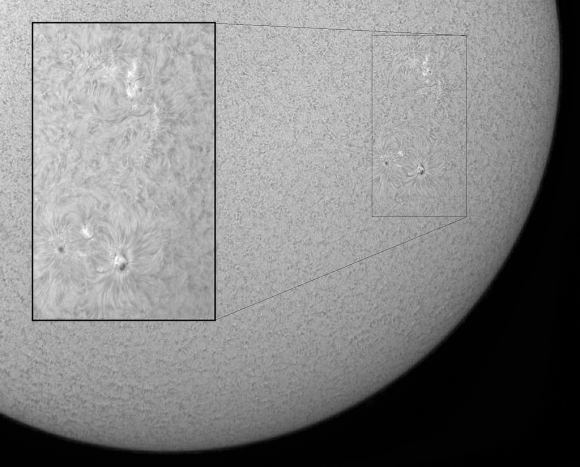
But how do we know that a new solar cycle has arrived, and that a given sunspot is a member?
Two factors come into play with identifying that a new solar cycle is indeed underway: the appearance of new sunspots at relatively high solar latitudes, and the reversal of the Sun’s magnetic field.
The first factor can be seen observationally in white light over the span of a solar cycle, and was first identified by Richard Carrington in 1861 and later refined by Gustav Spörer, in a law that now bears his name. Chart out the appearance of sunspots over time by latitude, Spörer noticed, and you get a tidy ‘butterfly graph’ depicting the 11-year solar cycle from minimum to maximum.
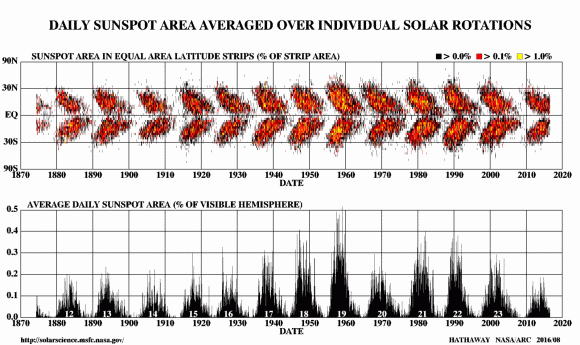
The second piece of the puzzle had to wait for the arrival of 20thcentury technology for astronomers to uncover it. It was known throughout the 19th century that there was a magnetic component to the Sun, as displayed by the electromagnetic havoc and enhanced auroral activity that solar storms could induce on Earth. In 1908, George Ellery Hale—a pioneer in American astronomy—used the newly installed 60-foot solar tower telescope at the Mount Wilson Observatory to note that spicule swirls around sunspot pairs rotated in opposite directions, much like metal fibers on a sheet of paper in the presence of a magnetic field in high school science class.

Hale used the 9-meter Littrow spectrograph attached to the solar tower telescope to exploit what’s known as the Zeeman effect—where a sunspot spectrum shows either a split or a broadening, evidence of its polarity—to deduce the magnetic field of the given spot. Hale showed that the Sun actually reverses its robust magnetic field every solar cycle, and the reversal period of 22 years whereas the same hemisphere returns to the same cycle is known as the Hale Cycle.
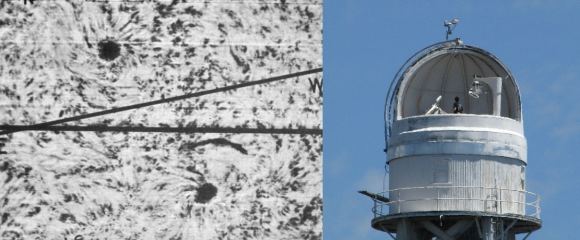
Likewise, sunspot pairs in the northern or southern hemisphere of the Sun show up as reversed in opposition to each other on magnetograms, showing spatial movement of the magnetic fields within the sunspot group, with one dark segment (south polarity, moving inward) and one bright segment (north polarity, moving outward). Remember that swirling action that Hale noted? Well, looking at the magnetogram of a given sunspot, you see either the bright spot leading or trailing the group versus solar rotation, and this flips when the Sun’s poles reverse every solar cycle.
Horace Babcock built and installed the first true magnetogram imager on the 150-foot solar telescope on 1957, allowing him to take the first true magnetogram TV image of the Sun, which took the device about an hour to produce.
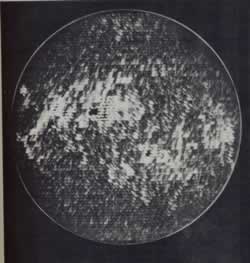
Today, you can see the very latest magnetogram image of the Sun with the flick of a smartphone, courtesy of the Solar Heliospheric Observatory (SOHO) and NASA’s Space Weather App.
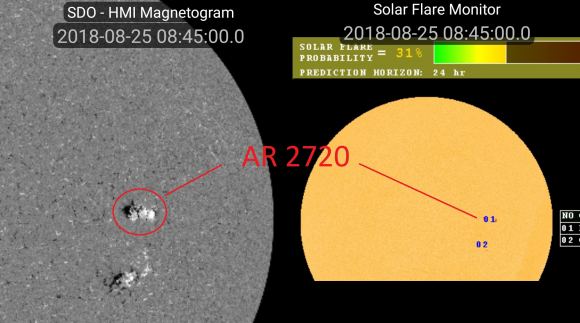
Which brings us back to the curious case of sunspot active region 2720. It was indeed showing a bright leading edge matching its southern counterpart (such mixing isn’t uncommon around the time the solar cycle flips) a strike in the ‘for’ category, but its latitude is still pretty low, a strike against. Another anomalous spot seen this past April also seems to have belonged to the next solar cycle.
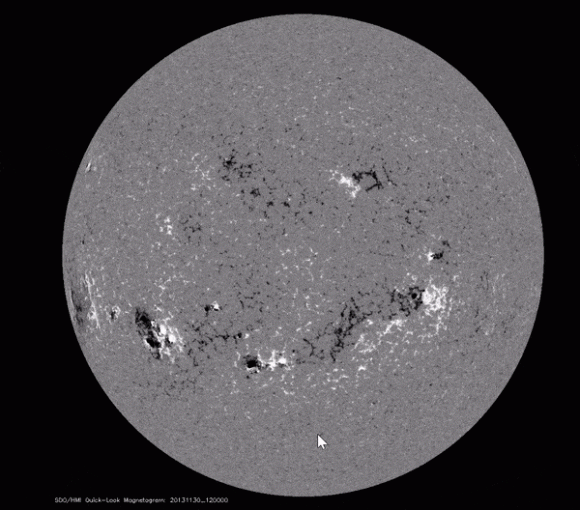
One thing is for certain: the Sun is a fascinating subject of study, and will continue to surprise. Keep those solar filters handy, watch those magnetograms online, and we’ll see what AR 2720 does when it comes back ’round the solar limb in about 12 days.
(Our thanks to astronomer Karl Battams at the U.S. Naval Research Laboratory helping us explain the process of identifying a sunspot’s solar cycle membership!)
WHO and WHAT is behind it all ? : >
The bottom line is for the people to regain their original, moral principles, which have intentionally been watered out over the past generations by our press, TV, and other media owned by the Illuminati/Bilderberger Group, corrupting our morals by making misbehavior acceptable to our society. Only in this way shall we conquer this oncoming wave of evil.
Commentary:
How are the readings of the past? Is it not caused by the 11 year solar cycle?
Administrator
HUMAN SYNTHESIS
All articles contained in Human-Synthesis are freely available and collected from the Internet. The interpretation of the contents is left to the readers and do not necessarily represent the views of the Administrator.
Disclaimer: The contents of this article are of sole responsibility of the author(s). Human-Synthesis will not be responsible for any inaccurate or incorrect statement in this article. Human-Synthesis grants permission to cross-post original Human-Synthesis articles on community internet sites as long as the text & title are not modified. The source and the author's copyright must be displayed. For publication of Human-Synthesis articles in print or other forms including commercial internet sites.
Human-Synthesis contains copyrighted material the use of which has not always been specifically authorized by the copyright owner. We are making such material available to our readers under the provisions of "fair use" in an effort to advance a better understanding of political, economic and social issues. The material on this site is distributed without profit to those who have expressed a prior interest in receiving it for research and educational purposes. If you wish to use copyrighted material for purposes other than "fair use" you must request permission from the copyright owner.